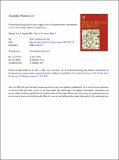Files in this item
Constraining timing and tectonic implications of Neoproterozoic metamorphic event in the Cathaysia Block, South China
Item metadata
| dc.contributor.author | Yao, Jinlong | |
| dc.contributor.author | Shu, Liangshu | |
| dc.contributor.author | Cawood, Peter A. | |
| dc.contributor.author | Li, Jinyi | |
| dc.date.accessioned | 2018-02-18T00:32:54Z | |
| dc.date.available | 2018-02-18T00:32:54Z | |
| dc.date.issued | 2017-05 | |
| dc.identifier | 249183979 | |
| dc.identifier | 34864815-de41-4e56-b195-44a418fecb53 | |
| dc.identifier | 85014763944 | |
| dc.identifier | 000400213500001 | |
| dc.identifier.citation | Yao , J , Shu , L , Cawood , P A & Li , J 2017 , ' Constraining timing and tectonic implications of Neoproterozoic metamorphic event in the Cathaysia Block, South China ' , Precambrian Research , vol. 293 , pp. 1-12 . https://doi.org/10.1016/j.precamres.2017.01.032 | en |
| dc.identifier.issn | 0301-9268 | |
| dc.identifier.other | RIS: urn:27C2781A9195DBF19FDD0153B0AE7D7E | |
| dc.identifier.uri | https://hdl.handle.net/10023/12745 | |
| dc.description | We acknowledge the financial support by the Major State Research Development Program of China (Grant No. 2016YFC0600202), National Natural Science Foundation of China (Nos. 41330208 and 41572200) and State Key Laboratory for Mineral Deposits Research (Nanjing University) (ZZKT-201603). | en |
| dc.description.abstract | The Cathaysia Block of the South China Craton includes a Proterozoic basement that experienced a prolonged Precambrian crustal evolution but to date lacks evidence of Proterozoic metamorphic ages. At Lichuan and Jianning, in the Wuyi Domain of the eastern Cathaysia Block, Proterozoic rock units include migmatized paragneiss of the Wanyuan Group and minor amphibolite of the Tianjingping Formation, which are enveloped by schist of Mayuan Group, and all are intruded by Paleozoic and Mesozoic igneous rocks. Detrital zircon grains from the Wanyuan paragneiss display metamorphic rims that yield concordant weighted average 206Pb/238U ages of 860 ± 6 Ma and 435 ± 5 Ma, along with variably disconcordant ages with lower intercept ages of 442 ± 41 Ma. The zircon core ages range from 3015 Ma to 851 Ma, with three major age populations at 930–865 Ma, 1850–1200 Ma and 2650–2400 Ma. Detrital zircon grains from Mayuan schist samples at Jianning generally lack core-rim structures and yield three main age populations at 860–736 Ma, 1835–1775 Ma and 2720–2500 Ma. Metamorphic ages of ca. 860 Ma and ca. 435 Ma for the Wanyuan paragneiss along with the youngest detrital zircon constrain the depositional age of the protolith to ca. 865–860 Ma, whereas the Mayuan Group is younger and probably deposited after ca. 736 Ma. Characteristics of detrital zircon age populations along with regional geological data suggest accumulation of the Wanyuan Group in a convergent and/or collisional setting. Metamorphism and a possible subduction -collision process within the Cathaysia Block at around 860 Ma suggest it was not a unified block in early Neoproterozoic. The growth of ca. 440 Ma metamorphic rims is likely related to granitic magmatism, such as that exposed in the Lichuan region. The sparse evidence for early Neoproterozoic metamorphism likely reflects widespread overprinting by the Paleozoic tectonothermal event at around 440 Ma. | |
| dc.format.extent | 12 | |
| dc.format.extent | 12234072 | |
| dc.language.iso | eng | |
| dc.relation.ispartof | Precambrian Research | en |
| dc.subject | Detrital zircon | en |
| dc.subject | Geochronology | en |
| dc.subject | Paragneiss | en |
| dc.subject | Early Neoproterozoic metamorphism | en |
| dc.subject | Cathaysia Block | en |
| dc.subject | South China | en |
| dc.subject | GE Environmental Sciences | en |
| dc.subject | DAS | en |
| dc.subject.lcc | GE | en |
| dc.title | Constraining timing and tectonic implications of Neoproterozoic metamorphic event in the Cathaysia Block, South China | en |
| dc.type | Journal article | en |
| dc.contributor.institution | University of St Andrews. Earth and Environmental Sciences | en |
| dc.contributor.institution | University of St Andrews. School of Geography and Geosciences | en |
| dc.contributor.institution | University of St Andrews. Scottish Oceans Institute | en |
| dc.contributor.institution | University of St Andrews. St Andrews Isotope Geochemistry | en |
| dc.identifier.doi | https://doi.org/10.1016/j.precamres.2017.01.032 | |
| dc.description.status | Peer reviewed | en |
| dc.date.embargoedUntil | 2018-02-17 |
This item appears in the following Collection(s)
Items in the St Andrews Research Repository are protected by copyright, with all rights reserved, unless otherwise indicated.

